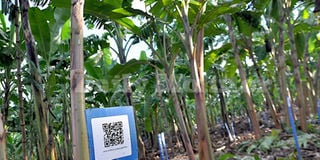Modern track system to boost banana yields

Barcoded banana plants in a banana breeding field. PHOTO/LOMINDA AFEDRARU
What you need to know:
- Apart from parental pedigree and taste details, BTracT records agronomic performance, pest resistance, plant stature, colour and feel of cooked bananas.
Tagging products with barcodes for easy price retrieval in supermarkets is a regular practice.
But beyond supermarkets, barcodes can be employed across a whole spectrum of settings, including by scientists in their research.
The accelerated breeding better banana project has developed and deployed a fully operational Banana breeding Tracking Tool (BTracT) which uses barcodes.
Researchers now use BTracT to routinely track each step of the breeding process of the breeding pipeline from where the male parent’s pollen comes from to how the cooked product tastes.
Barcoded plants
Each plant in each location receives a specific barcode identity. Apart from parental pedigree and taste details, BTracT records agronomic performance, pest resistance, plant stature, colour and feel of cooked bananas.
These details are stored on the global banana breeding database called Musabase for everyone to access.
The banana breeding process is extensive and the performance of plants studied over several years can help identify the best performing and most suitable bananas with the most desired traits.
“Having real time upload of data allows supervisors to keep track of operations while away from the station. If a problem occurs, I am aware of it almost at the same time as the people on the ground,” says Allan Brown a banana breeder at the International Institute of Tropical Agriculture’s Sendusu Farm in Namulonge.
Why low banana yields
While banana is an important food and cash crop for millions of subsistence farmers in developing countries, its yield is still low.
In Uganda, for example, the average yield of banana is 10 tonnes per hectare per annum yet it has a potential yield of 60 tonnes per hectare per year and above. The low yield is attributed to both abiotic and biotic constraints.
Averting low yields
Banana breeding is the most feasible intervention to solve these constraints and this involves several extensive steps. Accurately tracking a breeding programme’s progress and performance at all the different levels is an involving and time-consuming activity but BTracT simplifies this process.
By helping identify the best hybrids without laboriously wading through reams of data, BTracT is transforming banana breeding and revolutionising the whole process.
How BTracT operates
BTracT allows data capture on handheld devices, synchronizes data from various locations and enables querying and analytics on a central dashboard.
“This definitely makes data collection much more efficient and accurate, to the joy of the research assistants. We now receive data much more timely, usually the day after collection,” said Violet Akech, a research associate on banana improvement at Sendusu.
BTracT is now fully operational with the IITA banana breeding programmes in Sendusu, Uganda and Arusha, Tanzania, across the entire workflow. It is also fully integrated into Musabase enabling seamless real-time data handling and data flow.
Several private companies involved in banana tissue culture and seedling distribution systems are already enthusiastic about adapting BTracT into to their systems. The banana breeding team is working closely with all interested partners to extend the use of BTracT to various breeders.
Low yields
While banana is an important food and cash crop for millions of subsistence farmers in developing countries, its yield is still low. In Uganda, for example, the average yield of banana is 10 t/ha/year, yet has a potential yield of 60 t/ha/year and above. The low yield is attributed to both abiotic and biotic constraints.




